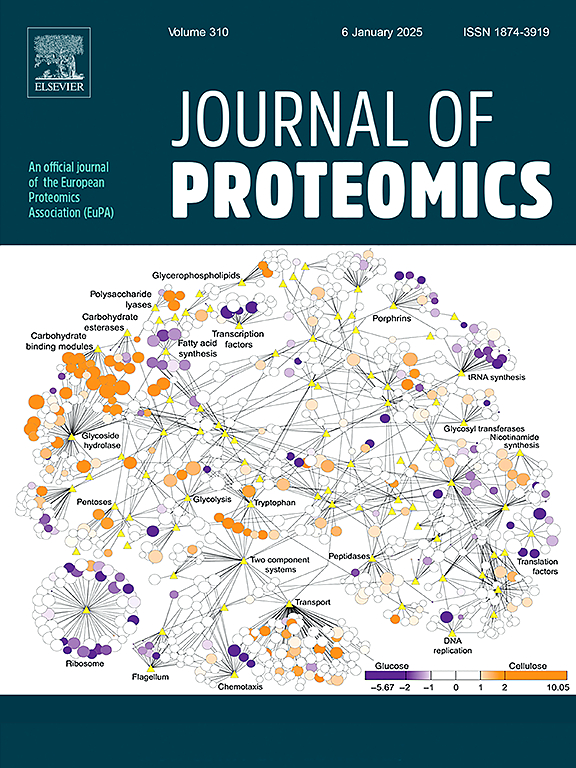Comparative proteomic analysis of residual proteins in waterlogged ancient leather
IF 2.8
2区 生物学
Q2 BIOCHEMICAL RESEARCH METHODS
引用次数: 0
Abstract
Leather artifacts hold significant historical and cultural value in human civilization. During long-term preservation, ancient relics, especially waterlogged leather artifacts, are susceptible to protein degradation. Therefore, analyses of the structure and protein composition of these ancient relics are crucial for their effective conservation. However, comprehensive research in this field is scarce and urgently needed. In this study, systematic investigations of the structures of fresh vegetable-tanned leather, dried leather artifacts, and waterlogged leather artifacts were performed from multiple perspectives. Compared with fresh vegetable-tanned leather and dry leather artifacts, the deterioration of waterlogged leather artifacts resulted in a darkened color, increased brittleness, and reduced fiber structure. Infrared analyses revealed that the characteristic peaks of the amide II and III bands were nearly absent in waterlogged leather artifacts. The species of the leather artifacts were analyzed using enzyme-linked immunosorbent assay (ELISA). Furthermore, comparative proteomic analysis revealed a markedly reduced repertoire of protein species in waterlogged leather artifacts compared with fresh vegetable-tanned leather. In particular, the number of peptides derived from type I collagen and other structural proteins was substantially diminished. This loss of collagen- and structure-related peptides, together with extensive fiber disintegration, underlies the pronounced morphological deterioration observed in waterlogged leather. By integrating species identification through ELISA with proteomic profiling, we establish a strategy that enables rapid, sensitive, and specific characterization of leather proteins.
Significance
This study integrated stereomicroscopy, scanning electron microscopy (SEM), and fourier transform infrared spectroscopy (FTIR) to systematically characterize morphological and microstructural differences between fresh vegetable-tanned leather and archaeological waterlogged leather artifacts. To further unravel residual proteins, comparative proteomic profiling was implemented to identify compositional shifts in collagenous proteins resulting from prolonged waterlogged burial conditions. A multidisciplinary approach was used to assess the characteristics of waterlogged leather artifacts.

浸水古皮革中残留蛋白质的比较蛋白质组学分析。
皮革制品在人类文明中具有重要的历史文化价值。在长期保存过程中,古代文物,特别是浸水的皮革制品,容易受到蛋白质降解的影响。因此,对这些古代文物的结构和蛋白质组成进行分析对其有效保护至关重要。然而,这方面的综合研究还很缺乏,迫切需要。本研究从多个角度对新鲜植物鞣制皮革、干燥皮革制品和浸水皮革制品的结构进行了系统的研究。与新鲜的植物鞣制皮革和干皮革制品相比,浸水后的皮革制品颜色变暗,脆性增加,纤维结构减少。红外分析表明,浸水皮革制品中酰胺II和酰胺III波段的特征峰几乎不存在。采用酶联免疫吸附法(ELISA)分析皮革制品的种类。此外,比较蛋白质组学分析显示,与新鲜的植物鞣制皮革相比,浸过水的皮革制品中的蛋白质种类明显减少。特别是,来自I型胶原蛋白和其他结构蛋白的肽的数量大大减少。这种胶原蛋白和结构相关肽的损失,以及广泛的纤维解体,是在浸水皮革中观察到的明显形态恶化的基础。通过将酶联免疫吸附试验与蛋白质组学分析相结合,我们建立了一种策略,能够以前所未有的分辨率快速、敏感和特异性地表征皮革蛋白质。意义:本研究综合运用立体显微镜、扫描电镜和傅里叶变换红外光谱技术,系统表征了新鲜植物鞣制皮革与考古浸水皮革制品在形态和微观结构上的差异。为了进一步揭示残留蛋白,我们实施了比较蛋白质组学分析,以确定长期浸水掩埋条件下胶原蛋白的组成变化。一种多学科的方法被用来评估浸水皮革文物的特征。这为其预防性保护提供了科学依据。
本文章由计算机程序翻译,如有差异,请以英文原文为准。
求助全文
约1分钟内获得全文
求助全文
来源期刊

Journal of proteomics
生物-生化研究方法
CiteScore
7.10
自引率
3.00%
发文量
227
审稿时长
73 days
期刊介绍:
Journal of Proteomics is aimed at protein scientists and analytical chemists in the field of proteomics, biomarker discovery, protein analytics, plant proteomics, microbial and animal proteomics, human studies, tissue imaging by mass spectrometry, non-conventional and non-model organism proteomics, and protein bioinformatics. The journal welcomes papers in new and upcoming areas such as metabolomics, genomics, systems biology, toxicogenomics, pharmacoproteomics.
Journal of Proteomics unifies both fundamental scientists and clinicians, and includes translational research. Suggestions for reviews, webinars and thematic issues are welcome.
 求助内容:
求助内容: 应助结果提醒方式:
应助结果提醒方式:


